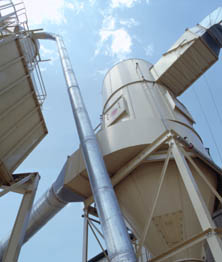Pneumatic Conveying Systems

Pneumatic Conveying Systems
Pneumatic Conveying Systems TN. - moving solids suspended in or forced by a gas stream through horizontal and/or vertical pipes.Pneumatic Conveying is one of the most practical methods for moving large amounts of dry powdered, granulated, or pelletized materials. Product or waste materials with bulk densities ranging from 1 to 200 lb/ft3 are conveyed by being suspended in or forced by a gas stream in horizontal or vertical pipes.
Low Pressure and High Pressure Systems are used to convey materials from point A to point B or multiple locations, and the type of system depends on the physical characteristics of the material, the rate of material flow, and the distance that the material must travel.
Types of Pneumatic Conveying Systems
Low Pressure Systems
Low Pressure Systems are used to move less abrasive, smaller amounts of material over a shorter distance where the differential pressure is typically below 20” w.c. Negative or positive pressure systems can be used depending on the design parameters and whether or not the system is picking up from multiple points.
High Pressure Systems
High Pressure Systems are used to move more abrasive or larger amounts of material over a greater distance and the differential pressure can be well over 20” w.c.
Dilute Phase Conveying
The most cost effective, simple, and versatile pneumatic conveying system design to use in a high pressure system is a Dilute Phase Conveying System. Known as suspension flow, these systems operate on the principle that the solids will be suspended in the air stream where the conveying velocity is typically greater than 3500 FPM. All dry bulk solid materials such as flours, wood dust, granular, and pelletized products will work in a dilute phase system.
A positive pressure system, vacuum system, or combination of both are all common ways to design a dilute phase system. Using a positive displacement blower with pressure capabilities of 2–15 PSIG, pressure systems utilize rotary airlocks to feed the material into the airstream. Vacuum systems can use a rotary airlock as well, but simply need a product flow control device such as a screw feeder.
Dense Phase Conveying
Dense Phase Conveying Systems operate below the minimum suspension velocity which results in the material being dragged along at a slower velocity than the conveying air. The material flows in intermittent surges or waves and the conveying velocity is typically below 2600 FPM. Product materials that have heavy bulk-densities, abrasive characteristics, or a need for gentle product handling are commonly conveyed using Dense Phase Systems.
Positive pressure systems are the most common dense phase system and will operate where the conveying gas will be compressed air with system pressures up to 80 PSIG. Vacuum Dense Phase Systems use high vacuum pumps and can be designed for simple operation, reduced horsepower, and ease of maintenance.